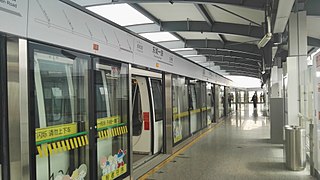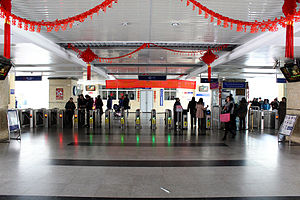
The Wuhan Metro is a rapid transit system serving the city of Wuhan, Hubei, operated by the Wuhan Metro Co., Ltd. The system began operation on July 28, 2004 with the completion of a ten-station long elevated line between Huangpu Road and Zongguan, making Wuhan the fifth city in mainland China to have a metro system after Beijing, Tianjin, Shanghai, and Guangzhou. Line 1 is the first metro line in China to have been wrongly referred to as a light rail system in Chinese terminology. As of February 2019, there are nine lines in operation, totaling 216 stations and 318 kilometres (198 mi) of system length. The daily ridership of Wuhan Metro ranges from 2,200,000 to 2,800,000.

Line 17 of the Shanghai Metro, also known as the Qingpu line, is an east-west rapid transit line that runs between Hongqiao Railway Station in Minhang District and Oriental Land in Qingpu District. It is 35.3 kilometres (21.9 mi) in length with 13 stations, and is colored light brown on system maps. The line entered passenger trial operations on 30 December 2017. It is the first metro line to primarily service the suburban Qingpu District.

The Wuhan–Jiujiang railway or Wujiu railway, is a double-track, electrified railroad in central China between Wuhan in Hubei Province and Jiujiang in Jiangxi Province. The line is 258 km (160 mi) long and follows the south bank of the Yangtze River from Wuchang District in Wuhan to Lushan Station in Jiujiang. Major cities and towns along route include Wuhan, Huarong, Huanggang, Ezhou, Huangshi, Daye Yangxin, Ruichang and Jiujiang.

The Line 1 of Wuhan Metro is an elevated metro line in the city of Wuhan, Hubei. It is the longest continuous metro viaduct in the world. Line 1 opened on 28 July 2004, making Wuhan the fifth city in mainland China to have a metro system after Beijing, Tianjin, Shanghai, Guangzhou. This is the first Metro line in China wrongly referred to as a light rail line in Chinese terminology because it is elevated. Originally a branch line was planned to cross the Yangtze to Wuchang District via the Second Wuhan Yangtze River Bridge. The Second Wuhan River Bridge even had a provision in the central median where Line 1 trains would run in anticipation for the branch line when it opened in 1995. However by 2003 the reservation was removed to allow for more traffic lanes when the bridge was undergoing renovation.

The Line 2 of Wuhan Metro is the first underground metro line crossing the Yangtze River. This line has started trial run on September 25, 2012, and has opened on December 28, 2012. It is Wuhan's second metro line after Line 1, and the city's first underground line, since Line 1 is mostly elevated. Line 2 runs in a northwest-southeast direction, connecting Hankou and Wuchang, including Hankou Railway Station and major commercial districts.

Dijiao is a station of Line 1 of the Wuhan Metro, opened along with the completion of Line 1 on July 29, 2010. It is an elevated station situated on Jiefang Avenue, with easy access to Dijiao Park and bus transfers to Hankou North. The station has two side platforms. Trains terminating at Dijiao Station uses a single crossover to access the westbound platform. The eastbound platform has entered fared service for Line 1's Hankou North extension on July 28, 2014.
Xinrong is a station on Line 1 of Wuhan Metro, opened along with the completion of Line 1, Phase 2 on July 29, 2010. It is an elevated station situated on Jiefang Avenue and located at the intersection of Jiefang Avenue and Hanhuang Road, with easy access to Xinrongcun Long Distance Bus Terminal and downtown bus transfers. The station has two side platforms serving trains from each direction.
Danshuichi is a station on Line 1 of Wuhan Metro, opened upon completion of Line 1, Phase 2 on July 29, 2010. It is an elevated station at the intersection of Jiefang Avenue and Handi Road. The name "Danshuichi" is derived from the dialectical pronunciation of "Duanshuichi". There are two side platforms and two tracks at Danshuichi.
Xuzhouxincun is a station on Line 1 of Wuhan Metro, opened along with the completion of Line 1, Phase 2 on July 29, 2010. It is an elevated station situated on Jiefang Avenue, with proximity to Erqi Yangtze River Bridge, Wuhan Erqi Memorial Hall, and downtown bus transfers. The station has two side platforms serving trains from each direction.

Erqi Road is a station on Line 1 of Wuhan Metro, opened upon the completion of Line 1 on July 29, 2010. It is an elevated station situated at the intersection of Jiefang Avenue and Erqi Road. The station has one island platform and two siding tracks to the north of the station, connected by a pair of crossover tracks, accommodating trains entering and exiting services during peak hours.

Toudao Street Station is a station on Line 1 of Wuhan Metro, opened upon completion of Line 1, Phase 2 on July 29, 2010. It is an elevated station located on Jiefang Avenue, close to Second Wuhan Yangtze River Bridge. There are two side platforms and two tracks at Toudao Street Station. A prefabricated bridge was installed south of the station to pass over railroad traffic at the Jiang'an Rail Yard, a freight yard which has since been demolished and redeveloped.
Sanyang Road Station serves as an interchange station of Line 1 and Line 7 of Wuhan Metro. The elevated station entered revenue service along with the completion of Line 1, Phase 1 on July 28, 2004, and the underground station entered service on October 1, 2018 with the opening of Line 7.

Dazhi Road Station serves as an interchange station of Line 1 and the planned Line 6 of Wuhan Metro. It entered revenue service along with the completion of Line 1, Phase 1 on July 28, 2004. The station situates at the intersection of Jinghan Avenue and Dazhi Road, immediately above the historic site of the Dazhimen Station of the depleted Jianghan Railway, which exited revenue service in 1991. The station is also adjacent to Wuhan Yangtze River Tunnel connecting Dazhi Road in Hankou to Youyi Avenue and Shahu Bridge in Wuchang. The underground platforms for Line 6 have not been built yet.

Wuhan Metropolitan Area intercity railway or Wuhan Metropolitan Area intercity railway system is a network of high-speed commuter railways in and around Wuhan, the capital of the Chinese province Hubei. The first line of the system opened at the end of 2013, two more in mid-2014, one in 2016.

Xunlimen Station is an interchange station between Line 1 and Line 2 of the Wuhan Metro. It entered revenue service along with the completion of Line 1 on July 28, 2004. The Line 2 platforms opened on December 28, 2012. It is located between Jianghan District and Jiangan District.

Taipingyang Station, or literally Pacific Station, is a station of Line 1 of Wuhan Metro. It entered revenue service on April 8, 2006. It is located in Qiaokou District.

Zongguan Station is a station of Line 1 of Wuhan Metro. It entered revenue service with the completion of Line 1, Phase 1 on July 28, 2004. It is located in Qiaokou District. The station has an island platform and a single-track crossover on the west end of the station. The station served as the terminus of Line 1 from 2004 to 2010. The Line 3's station will operate on December 28, 2015.

Trams in Wuhan may refer to any one of the tram systems currently operational in the city of Wuhan, Hubei, China. The first tram started revenue service in Wuhan is the Auto-city T1 Line, which began on July 28, 2017. Subsequently, Optics Valley tram started revenue service from April 1, 2018.

Dongchengyi Road is a station on the Pujiang line of the Shanghai Metro. The station is located at the intersection of Sanlu Highway and Dongchengyi Road, between Puhang Road and Huizhen Road, the southern terminus of the line. It began passenger trial operations with the rest of the Pujiang line on March 31, 2018.

Huizhen Road is a station on the Pujiang line of the Shanghai Metro. The station is located at the intersection of Lunan Road and Huizhen Road, and serves as the southern terminus of the line. The preceding station is Dongchengyi Road. It began passenger operations with the rest of the Pujiang Line on March 31, 2018.



















